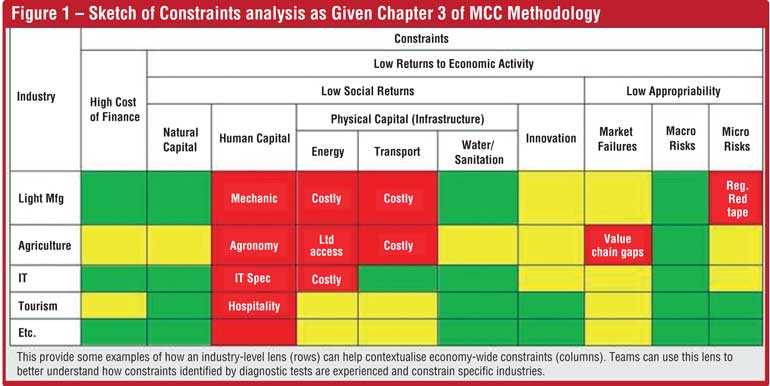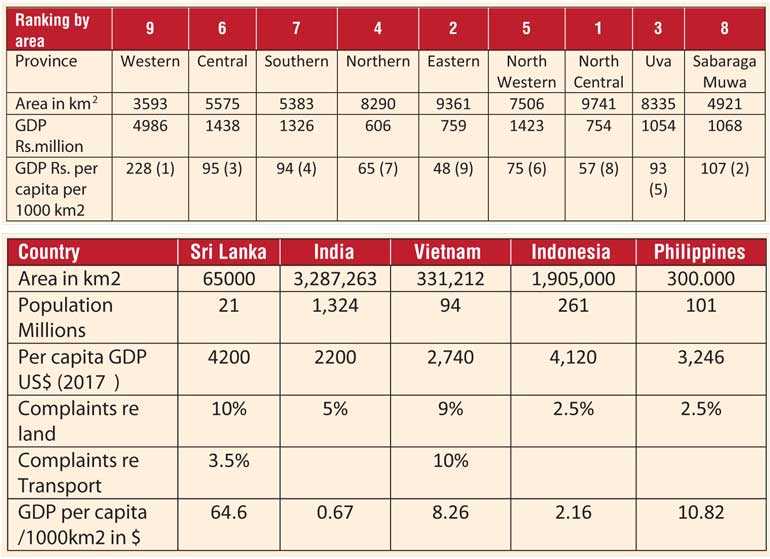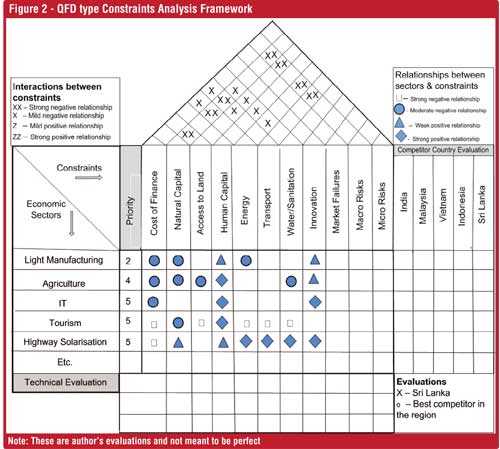Wednesday Jan 15, 2025
Wednesday Jan 15, 2025
Monday, 11 November 2019 00:00 - - {{hitsCtrl.values.hits}}

By K.C. Somaratna
When I wrote my previous article on MCC Compact and said that we need to redo the Constraints Analysis, I had already found a few weaknesses in the same and planned to write a second article explaining why that revision is necessary.
Theory of Constraints is something I have been using since December 1995 and I wish to quote from the first paragraph of the book ‘Theory of Constraints’ by S.K. Mukhopadhyay here. He mentions: “…. you must manage the constraint, otherwise the constraint will start managing you. Instead of you deciding the way things should happen, the constraint will decode the route of events.” This would be truer for Natural Capital than for any other.
When I started studying MCC compact for Sri Lanka I remembered this and subsequent thought processes were guided by same. I started reading Chapter 3 in MCC Compact Methodology, and then an article titled ‘Growth Diagnostics’ by Ricardo Hausmann, et.al. Reading these clearly indicated that this model has number of weaknesses.
Constraints Analysis model used by MCC
In my earlier article, I mentioned that Growth Diagnostics is not an advocate of economic growth at any cost. Here, of course, we do not have luxury of leaving these decisions on trade-offs to political processes, because climate risk vulnerability is knocking on our door for last three years – 2016-2019. Thus we attempted to study this methodology and identify how we could improve it and use it for future development of the country.
I have given this constraints analysis as Figure 1. In this, we could identify constraints which would hinder growth in different industrial/agricultural sectors identified in left-most column or what constraints would be affected by different sectors. According to Constraints Analysis – Sri Lanka 2017 document, MCC representatives have found out three constraints to be Access to Land, Tax Policy Uncertainty and Transportation. In this report they have explained what gave rise to this identification.
I intend to show (a) weaknesses in general approach given in Figure 1, (b) how they could be overcome using examples from similar matrices used in management and (c) specific issues with report prepared for Sri Lanka.
Weaknesses in Constraints Analysis approach
Neither Figure 1 nor any explanation in Chapter 3 indicate their method of capturing how individual constraints impact each other. Of course, Growth Diagnostics says: “In fact, Solution to a binding constraint yesterday could even negatively affect growth today,” and this could be doubly true for transport infrastructure in Sri Lanka.
But what I talk about here is the fact that an improvement in a particular constraint could impact another constraint adversely. The constraint which fall prey most to improvements in other constraints is Natural Capital. Improvements in Energy Capital, Transport Capital etc. could be impacting Natural Capital adversely.

Without indication of adverse effects, an improvement in one constraint could have on another – very often Natural Capital – a given development path could mean havoc for particular country. It is more so when you are second most vulnerable country in the world after Puerto Rico – US knows very much about this 9,000 km2 island in Caribbean with 3.2 million population and a nominal per capita GDP of $ 32,000 with high road density at 289 km/100km2 and GHG emission rate of 3110 t/km2. (USA’s Road Density is 68km/100km2 and GHG emission is 723/km2).
So, I categorically mention that this neglect of impact of improvement in one constraint or capital, on another makes this development approach a dangerous methodology – Puerto Rico is a living example – and it demands rectification.
Rectification of these weaknesses
It is for this purpose of identifying effect of improvement in one capital on another, we need to use Quality Function Deployment type matrices which is a very powerful tool. As indicated in Figure 2, it could be made to look at achievement of objective economic sectors given in left-hand side column. It then considers constraints identified in vertical columns indicated.
How we perform in comparison with other model economies – in same category as us – in respect of each constraint could be identified using three rows of squares at bottom of constraints section and how we fare in respect of many economic sectors in comparison with other comparative economies could be identified in right hand side columns.
It is the triangle indicated above constraints that will help us to overcome weakness in constraints analysis we identified earlier. It could be used to capture how individual constraints influence each other.
For a country like ours at 70N receiving 400 Wm-2 of solar radiation, any enhancement of road density currently at 148km/100km2 (compared to 48 in Vietnam, 35 in Thailand and 28 in Malaysia) will definitely – yes definitely – bring about serious repercussions in respect of droughts, heavy rain (of course at either different locations and/or different times) and landslides, earth slips, etc.
This is Natural Capital responding adversely to enhancements in transport infrastructure and generating macro risks.
I strongly believe we need to use such an extended or expanded constraints analysis framework if we are to escape falling prey to above-mentioned pitfalls associated with Constraints Analysis as it is.
Natural Capital – the key missing constraint
MCC Compact’s Constraints Analysis Report has a figure titled Summary Heat Map of Examined Potential Constraints and most important constraint for the country, with a per capita GDP per 1,000km2 about 10 times that for the US – Natural Capital – is missing in that. It is this criteria GDP per capita per 1,000 km2 that will indicate how much the Natural Capital in the country has been exploited or compromised already. Does this omission mean it is not a constraint?
Of course, one may say that why, they have spoken about access to land and they had meant Natural Capital by that. In the whole section on access to land, nothing is mentioned about trees, minerals, etc. and this shows that they only talk about land area.
 I believe designers of Constraints Analysis framework has included Natural Capital as a constraint to be evaluated for this reason. Actually speaking, it is the only real constraint and shortfalls in all others can be circumvented. Human Capital, Finance, etc. can be brought from abroad and others can be generated. If anyone wants to know more about Natural Capital, ‘Value of world’s Ecosystem services and Natural Capital’ by Robert Constanza, et al in Nature magazine is a readily accessible reference.
I believe designers of Constraints Analysis framework has included Natural Capital as a constraint to be evaluated for this reason. Actually speaking, it is the only real constraint and shortfalls in all others can be circumvented. Human Capital, Finance, etc. can be brought from abroad and others can be generated. If anyone wants to know more about Natural Capital, ‘Value of world’s Ecosystem services and Natural Capital’ by Robert Constanza, et al in Nature magazine is a readily accessible reference.
It identifies Natural Capital to consist of trees, minerals, ecosystems, atmosphere, et al and it categorically says that non-natural capital like machines, buildings cannot substitute for Natural Capital.
We need to bring to notice of MCC Management that this vital component in Constraints Analysis framework in their Chapter 3 is omitted in what their analysts have prepared for this small island.
It does not speak well of MCC.
I also wish to quote from that article by Robert Constanza et.al. following two statements because they are very relevant to issue in hand.
“We must begin to give the Natural Capital stock that produces these services adequate weight in the decision-making process; otherwise current and continued future human welfare may drastically suffer… Second important use of these estimates – for Natural Capital – is for project appraisal where ecosystem services lost must be weighed against benefits of a specific project.” These two statements clearly indicate that access to land is no substitute for Natural Capital. All this implies that this slip-shod Constraints Analysis is not worthy of an organisation like MCC.
Weakness of Constraints Analysis for Sri Lanka
Constraints Analysis Report for Sri Lanka – 2017 issued by MCC of the US is a very poor report for following reasons in addition to abovementioned defects in approach adopted.
1. Land access issues
I will mention only some key points.
It is writer’s opinion that land issue is an exaggerated issue for following reasons.
a). If land is an issue, provinces with highest areas should have highest provincial per capita per 1,000 km2 GDPs whereas it is not the case as could be seen in the table. It is the smaller provinces which has higher per capita per 1000 km2 GDP values. Let us take development to much larger provinces away from Colombo and elevate living conditions of people there
b). If somebody says that they need land for their expansions and also that land need to be in Western Province, then that may be something which cannot be fulfilled. But if that specificity is not there, there would be plenty of land available and we, Sri Lanka, can always facilitate improvement of the corresponding facilities for commercial operations
c). If we look at what we generate in way of per capita GDP per unit area we are way ahead not only of countries in Asia, but also global giants like the US and Australia, etc. The table presents some of the relevant figures (only approximations). With such a high per capita GDP per 1,000km2, you should be surprised only if Access to Land is not a constraint and are you surprised that India, Indonesia and Philippines do not have this constraint. This GDP per capita per 1,000km2 is only $ 6.36 and $ 7.75 for the US and Australia respectively. When they demand more land for economic development, we need to be mindful from where land would be allocated. Constraint Analysis says that in Sri Lanka, 80% of land is reportedly owned by the State. According to CBSL Annual Report 2018, there are two million hectares under main plantations, paddy, tea, rubber, coconuts which is approximately 31% of land area. We don’t mind land being State-owned if productively used
d). It is mentioned that Hambantota Economic Zone Park has 64% land vacant. I am surprised at this as when I was looking at a project in this zone around 2013, I saw allocations for almost all areas excepting about three plots. Most blocks had been reserved by motor vehicle importers. It appears that about 200 acres are vacant at Mirijjawila and it is our opinion that any capable investor willing to invest in Sri Lanka could operate from any of these zones. And now you have an expressway to industrial zone itself, an airport and seaport in the vicinity
e). If availability of land becomes a limitation to economic development – the above given tables clearly indicate it is not – what we should do is identify projects which are less land intensive or take development to the provinces where we have land. There had been leaders who did it very successfully by taking garment factories to the provinces. The ability of real economic planners could be gauged by their ability to do this
2. Transport issues
When I write about transport issues, I intend to write about what is given in the Constraints Analysis on this constraint.
a). It says that Sri Lanka’s Logistic Performance Index is indicated in the Figure 11 in Appendix in a foot note. But that Figure 11 refers to something about firms operating without formal registration
b). The report says on page 28 that it is only a few firms that report transportation is the main obstacle. We need to note that our road density at 148km/100km2 is a very high road density when compared with corresponding level countries as we had mentioned above
c). Then it does some travel speed comparisons between Sri Lanka, Malaysia, Vietnam and Thailand and conclude that Sri Lankan speed is the slowest. There is nothing to be surprised about this as order of travel speeds should be in reverse order of that for population densities and vehicle densities i.e. Malaysia’s population density 99.06 persons per km2, Thailand 122.29 persons per km2, Vietnam 285.52 persons per km2 and Sri Lanka 323.08 persons per km2. We would strongly argue against construction of any more roadways – MCC compact proposes that we upgrade a 131 km interprovincial road network – at our road density of 148km/100km and we are second most vulnerable country to climate risk in the world. We should not allow the US to do to us what they did to their vassal state of Puerto Rico in Caribbean. If we also keep on increasing our road density and GHG emissions without any control, this same fate would befall us
Critical evaluation of the Constraints Analysis Report
In view of all this we strongly urge MCC to carry out a fresh Constraints Analysis where they would also consider how an improvement in one constraint would influence other constraints as well. Our argument here had been that if we release one constraint it would most probably, bring about unbearable downgrading of some other constraint.
On the other hand, I would say that in this particular Constraints Analysis they have identified three constraints not in relation to any particular industrial sector but in general; at least this was the impression created.
We have a population of 22 million living here generating a total of $ 92.4 billion a year using this land of 65,000 km2. If Americans lived here with the same population as ours, they would have generated only $ 5.1 billion a year. That shows how productive we are in comparison to the Americans and that we are making very good use of our land.
What we need to do today is we should either (a) identify industrial sectors which are less land intensive or, (b) do some reclaiming land from the ocean surrounding us. This is what we are doing in Port City.
We, all Sri Lankans, know that our transport infrastructure improved considerably during first half of the decade and we had financing for those improvements. Still we achieved higher GDP growth rates. Today, we seem to be having necessary financing but not enough of a transport infrastructure to have a decent GDP growth rate. Is this due to what authors of ‘Growth Diagnostics’ meant when they said that a constraint when developed could become a binding constraint?
When more land capital is used for different industrial sectors, it will definitely hinder the eco-balance of natural system. Vegetation on this land capital carry out two important tasks in that they (i) absorb and thereby remove CO2 in the atmosphere and reduce ambient temperature and (ii) transport moisture in the ground to the atmosphere to comedown as rain and thereby facilitating water cycle as well as reducing atmospheric temperature. As such, use of this land capital to put up industries will definitely disturb this eco balance. And we are already suffering from inclement weather. With the weather gods not on our side, getting over the current economic mess is only a day dream.
Conclusion
In view of all these facts put forward above, we earnestly opine that this Constraints Analysis need to be carried out again using this new framework we have suggested wherein we take into account any maleficent effects that may arise from the suggested actions. Let them also correct the issues we have raised in this note, specially the one in respect of Natural Capital.
When one looks at this Constraints Analysis document one would realise that instead of identifying constraints in respect of some economic sectors, it identifies some general constraints which are said to be binding on all economic sectors across the board. But a constraint like Access to Land can’t be binding on all economic sectors while Policy Uncertainty could be so.
So what we would expect from personnel at MCC Compact is to redo this constraints analysis in a much more focused fashion and let us see how they could give this $ 480 million to benefit some more productive economic sectors and in order to help them in the process we have suggested a new economic sector which could be expanded to the tune of a few billions of dollars right across the country thereby eliminating at least a part of the strain on Natural Capital today.
(The writer is Managing Director at Somaratna Consultants Ltd.)